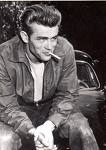
Clark Gable (1901-1960)
In my last two posts, I blogged about Clark Gable destroying undershirt sales when he took off his shirt in the 1934 Columbia picture “It Happened One Night” to reveal only bare skin and no undergarment. Men wanted to be like Gable and stopped buying undershirts. It would take a war, 17 more years, and another sexy actor before undergarments would become popular again. This time though, the t-shirt would jump from underwear to outerwear.
It was 1951, the actor was Marlon Brando, and the production was “A Streetcar Named Desire.” On Broadway and then on the big screen, Brando electrified audiences with his portrayal of the animalistic Stanley Kowalski who struts about in his stand-alone, outerwear t-shirt. Originally, the t-shirt was issued by the U.S. Navy (as early as 1913) as a crew-necked, short-sleeved, white cotton undershirt to be worn under a uniform. Although men did wear soft cotton tees after the war, they were worn for labor or under a dress shirt, but not to be seen in public. But Brando’s Kowalski is a brawny exhibitionist, fond of strutting about the streets in a tight, sweaty, smelly, and sticky tee that accentuates his massive torso and rippling biceps. Brando pulls the tee shirt up and over his head in one scene as he flirts with the sister-in-law, and in another scene, rips at his shirt in anguish as he cries upstairs to his wife with the unforgettable line, “Stella!” (Click to see.)

Actor James Dean (1931-1955)
Offscreen, Marlon Brando took the rebel fashion statement even further, pairing his white t-shirt with boots, motorcycle, and an anti-establishment sneer. It started a t-shirt craze. Next thing we know, movie icon James Dean (“Rebel Without A Cause,” see last post) borrows the Brando t-shirt, jeans and boots look but tops it off with a jeans jacket. From that point on, the t-shirt is set loose and becomes next the symbol of restless and rebellious American youth.






















